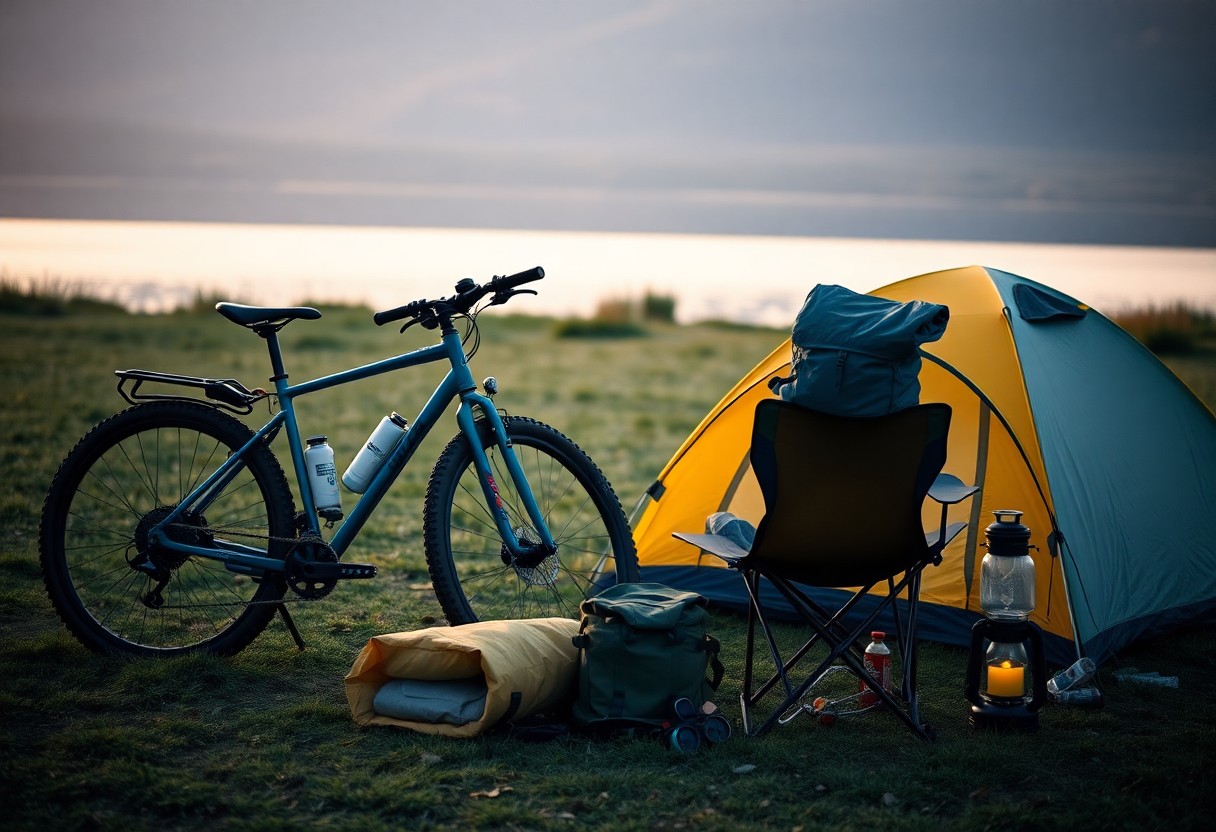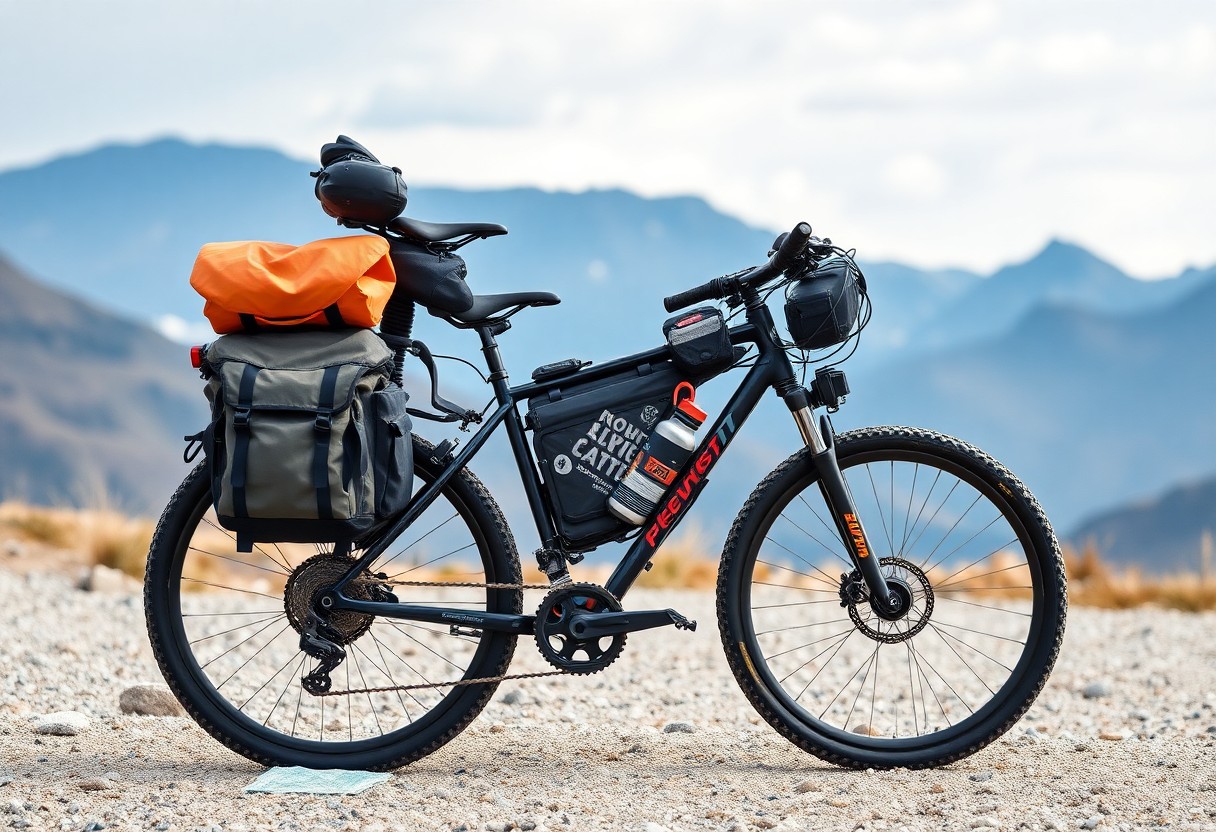Most bikepacking trips promise breathtaking scenery and exhilarating experiences, but being unprepared can turn your adventure into a nightmare. You need to equip yourself with necessary gear that prioritises your safety, comfort, and enjoyment. From the right camping equipment to proper tools for bike maintenance, having the right necessarys will enhance your journey and help you face unexpected challenges. In this guide, we’ll go over everything you need to make your next bikepacking adventure not only feasible but unforgettable.
Key Takeaways:
- Invest in a durable and weather-resistant bikepacking bag to secure your gear and withstand varied conditions during your journey.
- Prioritise a reliable navigation system, whether it’s a GPS device or a smartphone app, to ensure you stay on course and explore safely.
- Pack imperative tools and repair kits to address any mechanical issues that may arise, ensuring you remain self-sufficient throughout your adventure.
Gear That Makes or Breaks Your Journey
The right gear can be the difference between an enjoyable adventure and a harrowing ordeal. Choosing lightweight and reliable equipment will enhance your riding experience, ensuring you can tackle unexpected challenges on the road. Gear that’s ergonomically designed not only improves comfort but also increases efficiency, allowing you to ride longer distances without fatigue. Factors such as storage capacity, weight distribution, and ease of access should be considered carefully, as they impact your overall performance while bikepacking.
Selecting the Right Bike for Bikepacking
Your bike serves as the foundation of your bikepacking experience, so consider a model that combines comfort, durability, and versatility. Look for bikes with a sturdy frame and the ability to accommodate wider tyres, which offer better grip on varied terrain. Models like adventure bikes and touring bikes are particularly well-suited for this purpose. Features such as attachment points for racks and fenders will also enhance your loading capacity and protect your gear from the elements.
Essential Packing Tools and Accessories
The right packing tools and accessories can significantly enhance your bikepacking experience. Key items include a reliable multi-tool for on-the-go repairs, a portable pump for timely tyre inflation, and a basic first-aid kit to address any injuries. Additionally, consider including a compact cooking kit and adequate food storage solutions to fuel your journey. Each accessory plays a vital role in ensuring you’re self-sufficient and adequately prepared for any situation you may encounter on your adventure.
Investing in vital packing tools not only ensures you’re prepared for mechanical mishaps but also keeps you comfortable throughout your travels. For example, a high-quality multi-tool can handle minor bike repairs, enabling you to fix issues without being stranded. A lightweight, collapsible cooking kit allows you to prepare hot meals, which can be both enjoyable and energising during longer excursions. Also, consider packing a water filter to stay hydrated without the need for heavy supplies. These thoughtful additions will ultimately keep your adventure enjoyable and smooth, allowing you to focus on the journey ahead.
Navigating the Essentials: Clothing and Safety
Choosing the right clothing and safety gear is integral to ensuring a successful bikepacking trip. Comfort and safety go hand in hand, making it vital to select suitable attire and protective equipment that accommodate various weather conditions and road environments. Prioritise breathable, moisture-wicking fabrics and don’t overlook the significance of visibility, especially during dusk or in areas with heavy traffic.
Layering for Comfort: Clothing Choices
Opt for a layering system that allows you to adapt to fluctuating temperatures throughout your adventure. Start with a moisture-wicking base layer to keep sweat at bay, followed by an insulating mid-layer for warmth, and a waterproof outer layer to protect against the elements. Tailored shorts or padded bibs worn underneath ensure comfort during long rides, while lightweight gloves add grip and reduce hand fatigue.
Safety Gear: Helmets, Lights, and Visibility
Your safety on the road demands careful consideration of protective gear. A high-quality helmet is non-negotiable; look for one meeting safety standards, ideally with in-built adjustable ventilation. Enhance your visibility in low light with front and rear lights, as well as reflective elements on your gear. High-visibility clothing, such as bright colours or reflective vests, drastically reduces your chances of accidents and ensures that you are seen by motorists.
A well-fitted helmet should not only protect but also provide ventilation to prevent overheating during strenuous climbs. Bright, powerful front lights—aiming for at least 300 lumens—help illuminate your path, while rear lights should be flashing or pulsing to attract attention. Reflective ankle bands and vests can increase your visibility by up to 300%, making them invaluable during night rides or overcast days. The combination of these elements fortifies your safety on an adventure, allowing you to focus on the journey rather than potential hazards.
Sustenance on the Trail: Food and Hydration
Your body needs the right fuel to keep you going during those long days on the bike, so planning your meals and ensuring proper hydration is imperative for maintaining energy levels and promoting recovery. You’ll want to pack lightweight, nutrient-dense foods that are easy to prepare, such as dehydrated meals, energy bars, and trail mix. Staying hydrated is equally important; aim for at least 2-3 litres of water per day, adjusting according to weather conditions and exertion levels.
Meal Planning and Cooking Equipment
Efficient meal planning can transform your biking experience, allowing you to enjoy wholesome, satisfying meals on the go. A lightweight camping stove and a compact cooking pot can make all the difference, while simple to prepare meals like instant oatmeal or pasta can save time and energy. Including a multi-tool and a biodegradable sponge for cleaning will streamline the cooking process and help reduce your environmental impact.
Hydration Strategies for Endurance
Hydration shouldn’t be an afterthought; it plays a vital role in endurance performance during your bikepacking adventures. Carry a combination of water bottles and a hydration reservoir to ensure you have a convenient system for drinking. Consuming electrolyte tablets or sports drinks can also replenish lost minerals, keeping your body balanced and functioning optimally. Aim for a regular intake—sip water often rather than waiting until you feel thirsty to avoid dehydration.
It’s advisable to calculate your sweat rate during training to establish your fluid needs accurately. Weigh yourself before and after a ride to determine how much fluid you lose, then rehydrate accordingly. On hot days, you might need to increase your intake significantly, as heat can elevate the risk of dehydration. Planning water sources along your route and carrying adequate filtration options ensures you won’t run dry during your journey.

Shelter and Sleep: Creating Your Comfort Zone
Your bikepacking adventure doesn’t stop when the sun sets; the right shelter and sleep setup can transform rest stops into comfortable retreats. Choosing a location away from wind and disturbances is vital, but so is investing in quality gear. Whether opting for a tent or a hammock, ensuring you have something tailored to your needs will help you recharge for the next leg of your journey.
Tents vs. Hammocks: Choosing Your Shelter
Deciding between a tent or hammock hinges on your personal preference and the environment you’ll be traversing. Tents offer more protection from the elements and bugs, providing a contained space for gear and privacy. Hammocks, however, are incredibly lightweight and can be strung up almost anywhere, making them ideal for quick stops. Weigh the benefits based on your comfort and the terrain, and you’ll find your ideal shelter.
Sleep Systems: Sleeping Bags and Mattresses
A well-thought-out sleep system incorporates both sleeping bags and mattresses to ensure a restful night. Selecting a sleeping bag suited to the season is necessary, as these items are rated for specific temperature ranges, with options typically spanning from summer lightweight bags to winter-grade options. Pairing your bag with a quality sleeping pad adds an insulating layer, protecting you from the cold ground while also cushioning your body for an improved sleep experience.
Consider sleeping bags with down insulation for their excellent warmth-to-weight ratio, perfect for minimalist packers. Conversely, synthetic bags are more affordable and perform better in wet conditions. Your mat should ideally be inflatable or foam, offering comfort without excessive bulk, as a good night’s sleep significantly impacts your performance on the bike. Do not forget, investing in a lightweight, compact sleep system will pay dividends in your overall bikepacking experience, keeping you fresh and ready to hit the road again.
Tech That Enhances the Experience
Integrating technology into your bikepacking journey can significantly enrich your adventure. From navigation tools that guide you through unfamiliar terrain to gadgets that keep your devices charged, the right tech can ensure a smoother and more enjoyable ride. Make informed decisions on the gear that aligns with your needs, elevating your experience on the road.
GPS Devices and Navigation Apps
Reliable GPS devices and navigation apps transform the way you explore new landscapes. With features like offline maps and route planning, you can confidently traverse your chosen paths. Having a user-friendly interface that provides real-time data on your location can enhance your sense of security, making lost routes a thing of the past.
Charging Solutions: Power Banks and Solar Options
Maintaining power for your devices on long trips is vital, which is where power banks and solar charging options come into play. With a good-quality power bank, you can keep your phone and other gadgets charged for navigation or emergencies. Alternatively, portable solar panels allow you to harness renewable energy, making them a sustainable choice for extended adventures.
Opt for a power bank with at least 20,000mAh capacity to fully charge your phone multiple times during your journey. Pairing this with a lightweight, foldable solar panel can provide an eco-friendly solution to battery dependence. Some models offer direct solar charging while you ride, allowing you to stay connected without compromising your adventure. Make sure to test your charging solutions before hitting the road to ensure they meet your usage demands.
Final Thoughts on Bikepacking Essentials
As you plan your bikepacking adventure, assembling a well-thought-out list of importants will make all the difference. Prioritising items like a reliable sleeping system, versatile cooking gear, and important tools ensures you’re prepared for the unexpected. Lightweight, compact options are your best friends, allowing you to maximise comfort without compromising on necessities. Think about incorporating multi-functional gear; for instance, a tool that serves as both a repair kit and a bike lock can save space in your saddlebag. Ultimately, being adequately equipped not only enhances your enjoyment but also bolsters your confidence on the trail.
FAQ
Q: What items should I prioritise for shelter while bikepacking?
A: For shelter, a lightweight tent or a bikepacking-specific bivvy bag is vital to protect you from the elements. Additionally, consider packing a sleeping bag suitable for the temperatures you expect, and a sleeping mat for comfort and insulation from the ground. A compact tarp can also be advantageous for extra coverage in case of rain or as a communal area for cooking and relaxation.
Q: Which cooking equipment is vital for meals on the go?
A: When considering cooking, a lightweight stove is a must-have, along with a small pot or pan for boiling water or cooking meals. Don’t forget a reliable fuel source, as well as a basic set of utensils, such as a spork or knife. You may also want to pack a small cutting board and a multi-tool, which can serve various purposes while camping.
Q: What types of clothing should I take for various weather conditions during bikepacking?
A: Packing versatile clothing is key. Start with moisture-wicking base layers to keep you dry, then add insulating layers for warmth, such as a fleece or down jacket. A waterproof and breathable jacket is vital to shield you from rain, while padded shorts and gloves improve comfort on long rides. Lastly, appropriate footwear and extra socks will help keep your feet comfortable and dry throughout the adventure.
